In my ongoing attempt to stay cool, but still enjoy summer, I bring you the Watermelon!
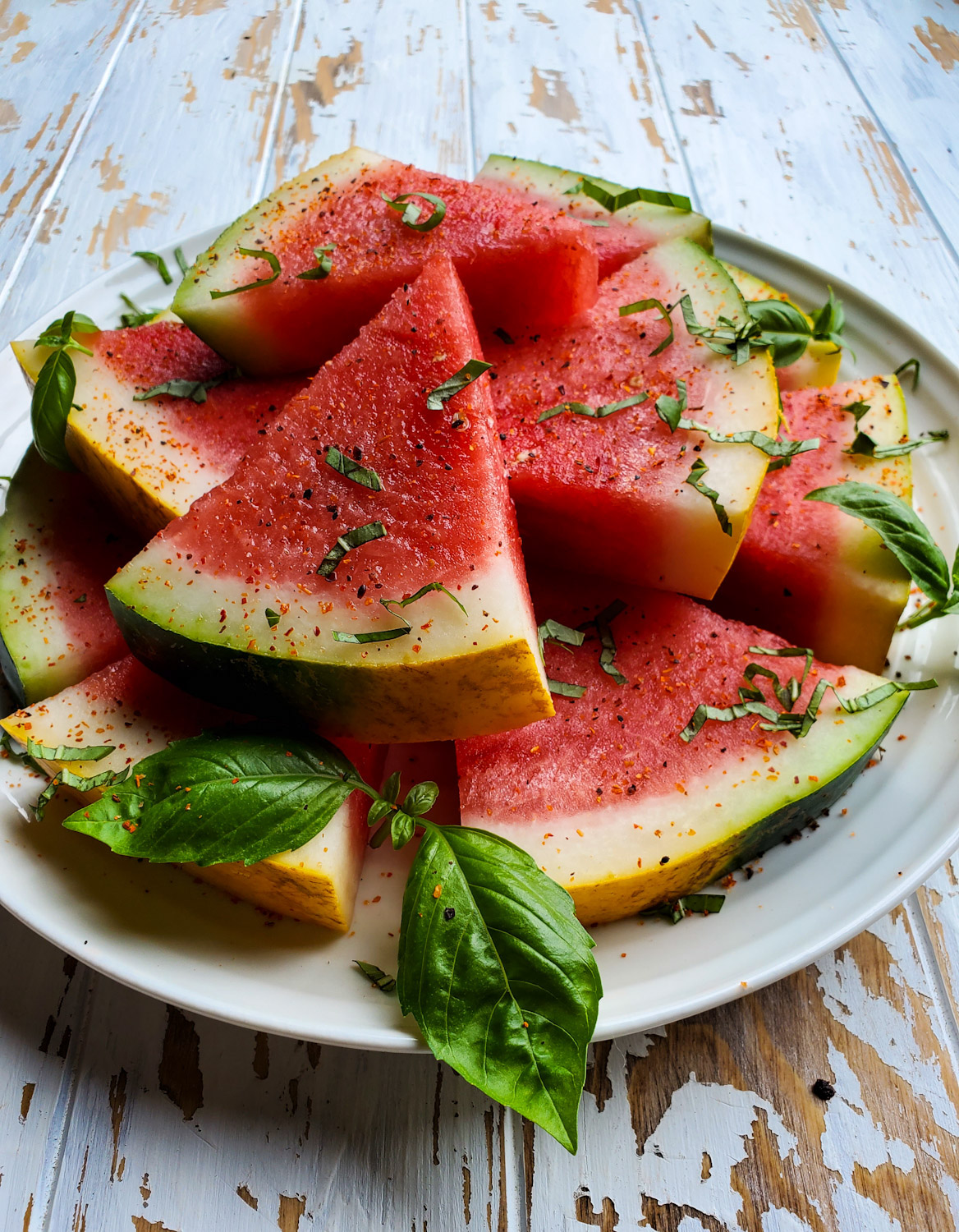 …you already know all about watermelon, duh. But did you know that this luscious fruit makes for a perfect dessert all on its own? Yes, as kids, we munched happily away on watermelon slices, spitting out the seeds all over the grass. But it also makes a wonderful treat for us adults.
…you already know all about watermelon, duh. But did you know that this luscious fruit makes for a perfect dessert all on its own? Yes, as kids, we munched happily away on watermelon slices, spitting out the seeds all over the grass. But it also makes a wonderful treat for us adults.
Sure, I could ask you to make a Watermelon Cake with it. After all, this is one of the most popular pins in my Pinterest account. But making a cake takes a bit of planning, and really is more for special occasions like anniversaries, showers, etc. So let’s be kind to ourselves, it’s hot out!
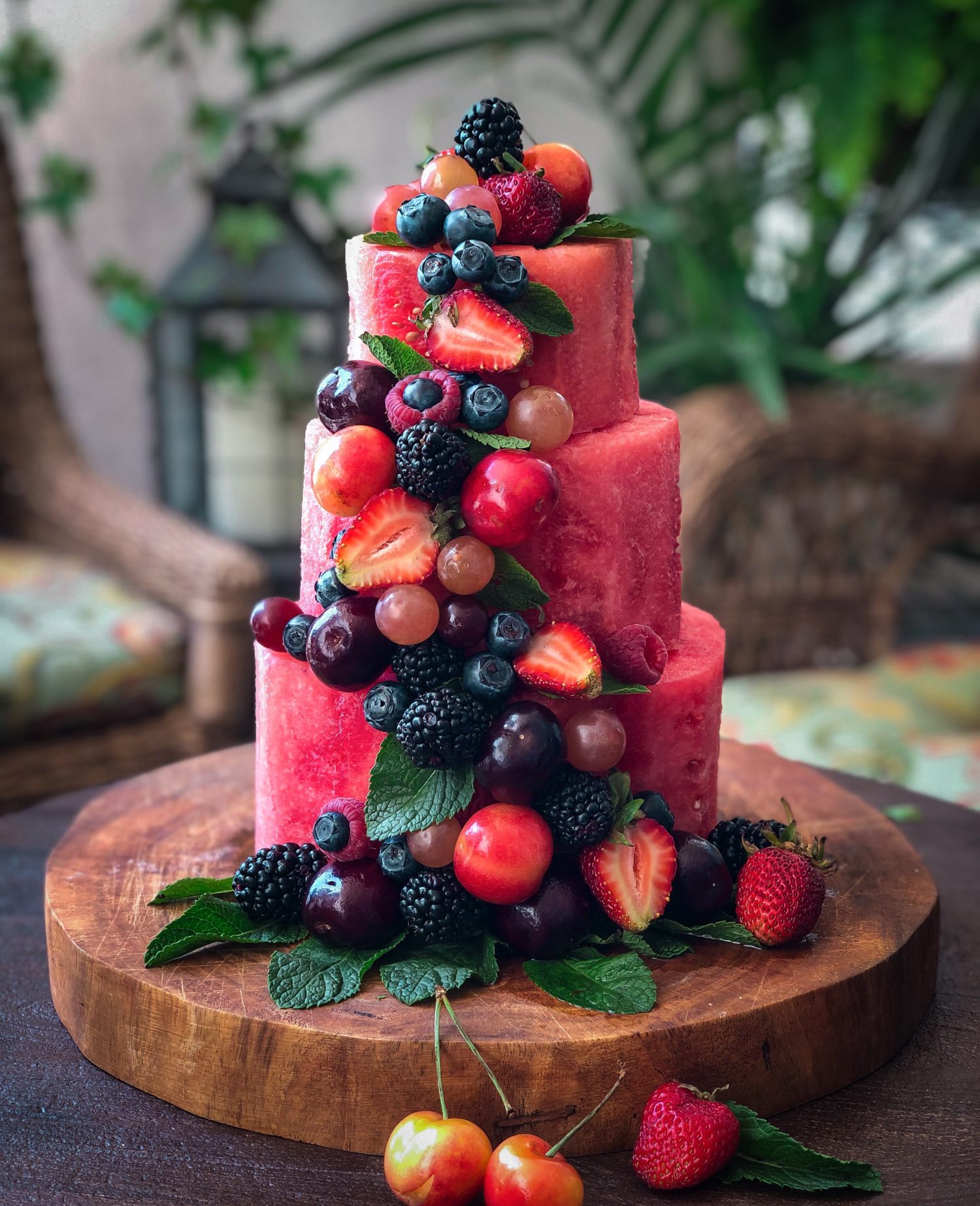
Global Influences
Here in North America we are late to the game on how to dress up watermelon with spices and herbs. From Mexican Tajín sprinkled watermelon, to Middle Eastern dishes involving mint and dukkah, you will love how the simple watermelon can be elevated to an exotic and festive treat.
Tajín: This is a fabulous Mexican dry seasoning blend of consisting of dried and ground red chilies, sea salt, and dehydrated lime juice. According to The Spruce Eats:
In Mexico, locals love to sprinkle it over fresh fruits and vegetables. It adds a wonderfully fresh, citrusy, and piquant taste to the fruit that combines perfectly with the fruit’s natural sweetness. As Tajín likes to say, it adds a “zing” to everything. For a summer treat it goes well over juicy slices of watermelon and mangos, crunchy bites of apples, or slices of cucumbers and jicama. You can sprinkle it over any of your favorite fruits or vegetables. Use the seasoning mix in marinades or spice rubs for chicken, fish, shrimp, and even steak for a completely different flavor. For those of you that love popcorn, next time sprinkle some Tajín over the kernels—it’s delicious!
Sumac: The dried berry from the sumac bush is crushed into a coarse powder, is a lovely dark purple and has a pleasant citrus presence. Masterclass has this to say about Sumac:
The sumac plant is a wild bush that primarily grows across the Mediterranean region, stretching from Italy to Greece to Lebanon. While sumac is most commonly used in the Middle East, and can be found cultivating in places like Turkey and Iran, the sumac flower is primarily grown in temperate and subtropical areas of Africa and North America.
Although the exact place of origin of this wild plant is unknown, sumac has been used for medicinal and culinary purposes around Europe, Africa, and the Middle East since medieval times, and was frequently used in Roman kitchens as a source of acidity prior to the arrival of lemons to the area.
Dukkah: An Egyptian blend of nuts, seeds and spices, this condiment is so versatile! Serious Eats has a great article on the history and uses for dukkah:
Dukkah (pronounced DOO-kah) gets its name from the Egyptian Arabic word for “to crush” or “to pound,” which is precisely how it’s made. Recipes vary but generally consist of cumin, coriander, sesame seeds, salt, dried herbs, and nuts (especially peanuts, which are widely available in Egypt). The ingredients are put into a mortar (or, increasingly, a food processor) and ground into a coarse powder, releasing aromatics in the process. It’s a versatile thing, both fine enough to sprinkle on as a garnish yet chunky enough to grab by the handful and eat as a snack, with a flavor profile that is specific to its place of origin yet thoroughly adaptable.
How to Put These Spices and Blends to Work with Watermelon
First of all, you need a good, ripe, juicy watermelon. You can slice it into wedges, into cubes, or into spears. Whatever will make it easy for your guests or family to enjoy it with minimal effort. Spread them out on a platter and dress them up. Have toothpicks or bamboo skewers handy for serving.
For the Tajín or Sumac, it is as simple as sprinkling the spices over the watermelon just before serving. Start with less, and leave the jars out for your guests to add extra if they so desire. Because it may be the first time for some to be tasting Tajín which does has a pleasant heat to it, it may take ones by surprise. But then they may suddenly realize that a bit more sprinkled on top is even better!
When it comes to the Dukkah, have the Dukkah in a small bowl on the side. Ones may choose to dip their spears or cubes right into the Dukkah, just as I suggest for my Dukkah with Bread Cubes appetizer. Alternatively, you can sprinkle the Dukkah over the wedges or cubes and serve the smaller cubes with toothpicks or on bamboo skewers.
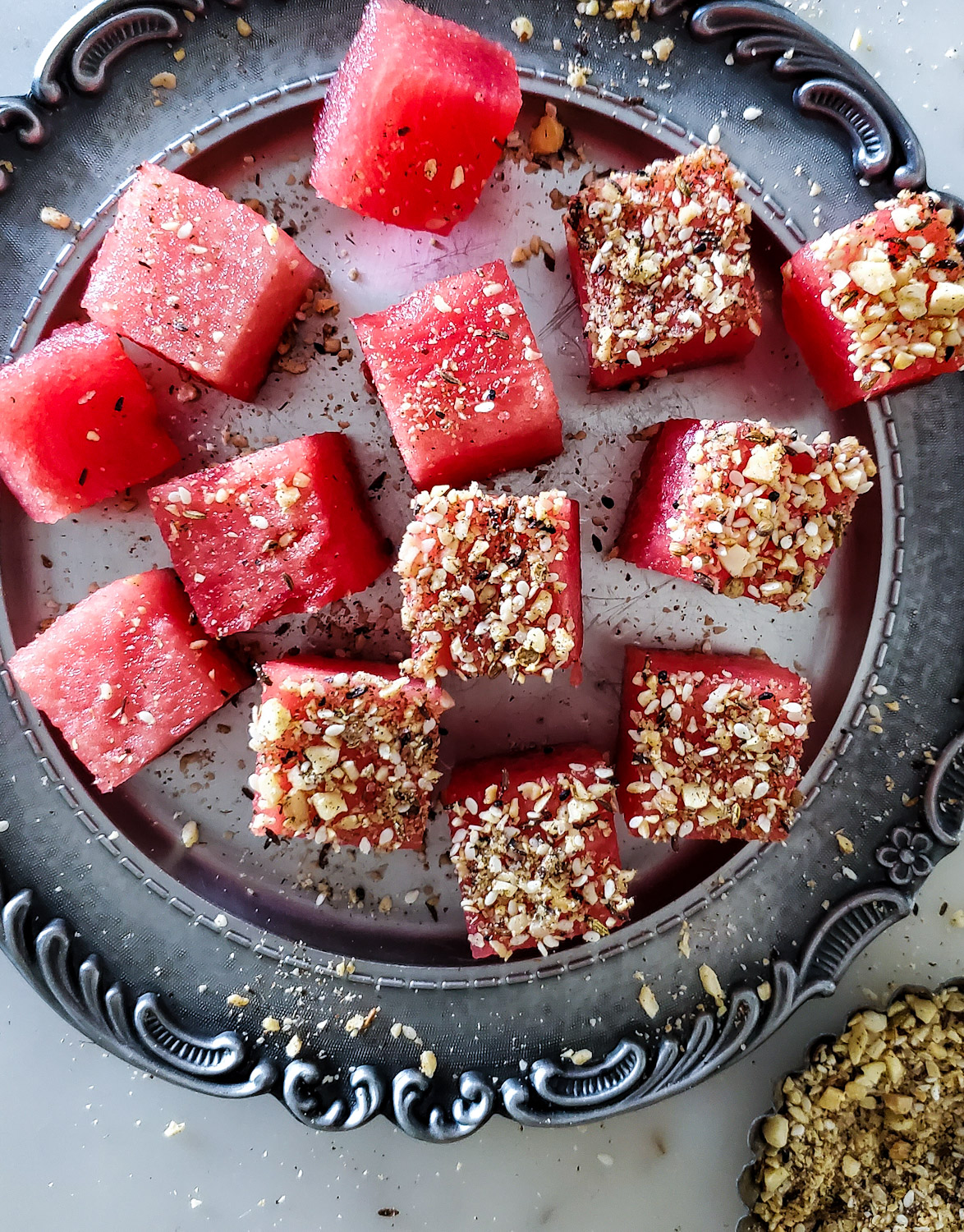
Using Herbs and Oils
Mint, basil, and thyme are all lovely fresh herbs to chop up and sprinkle over watermelon. The earthy and savoury nature is a fabulous contrast to the sweetness of the melon. Olive oil, white balsamic vinegar, and lime juice are also sensational with watermelon. How about a drizzle of honey, flakey salt and black pepper?! You don’t need to drown the watermelon, a lovely drizzle is all that is needed. But the impact of these savoury additions takes watermelon to the next level.
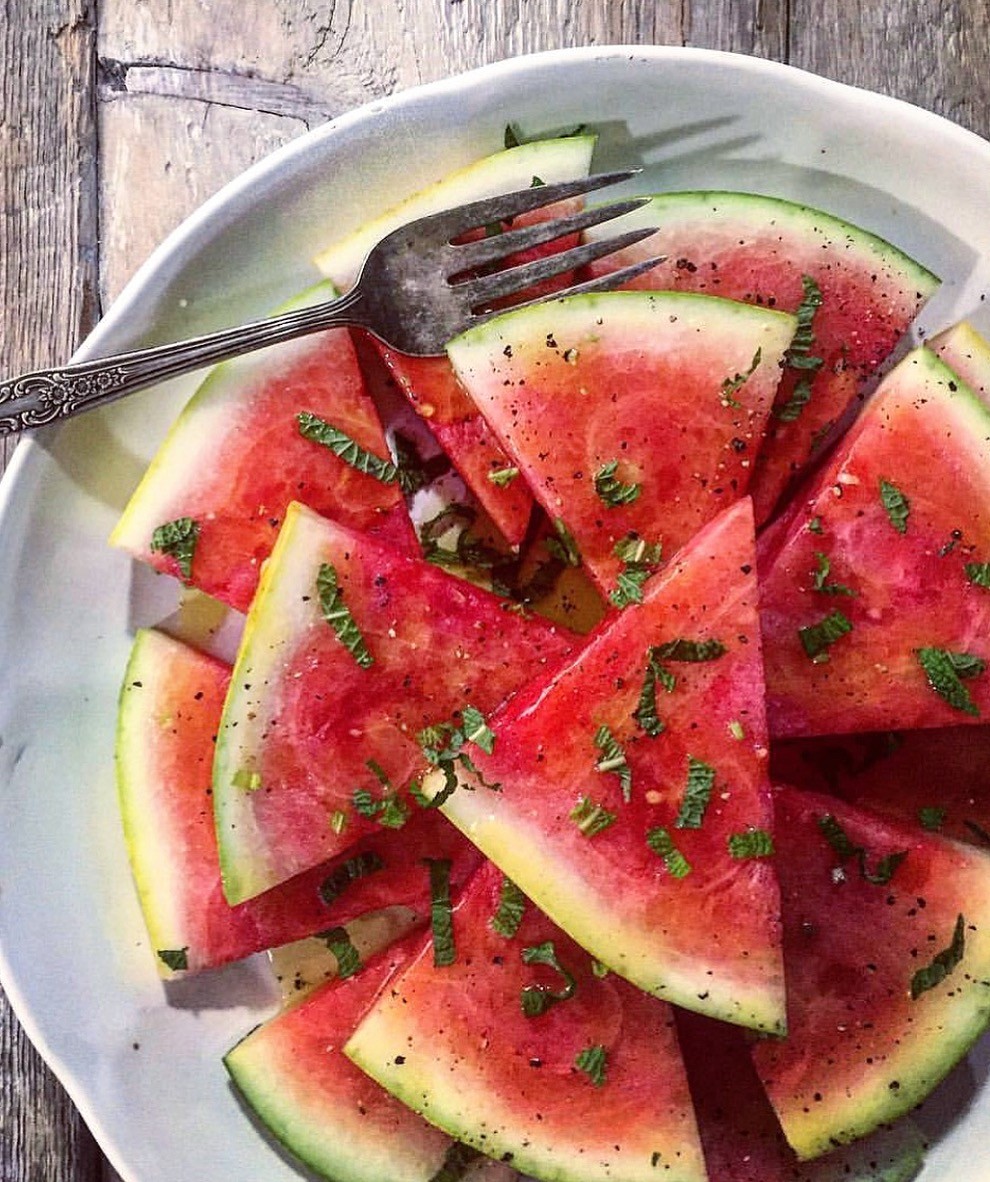
Final Thoughts
Choose one or two of the above suggestions and have fun. The Tajín and Sumac work great together. The Dukkah is all you need. Olive oil and vinegar will work with any of the herbs and simple seasonings. Honey and lime and salt and pepper are a great combo. After a large bbq or dinner, a platter of dressed up watermelon is really all that is needed to entertain in a relaxed way with no regrets. Watermelon isn’t heavy, has great nutritional and digestive properties, but is light and sweet enough to be the perfect finish to an evening of visiting with friends and family.
And if you want a liquid version of watermelon, you can’t beat a pitcher of Agua Fresca, spiked with gin or vodka if so desired!

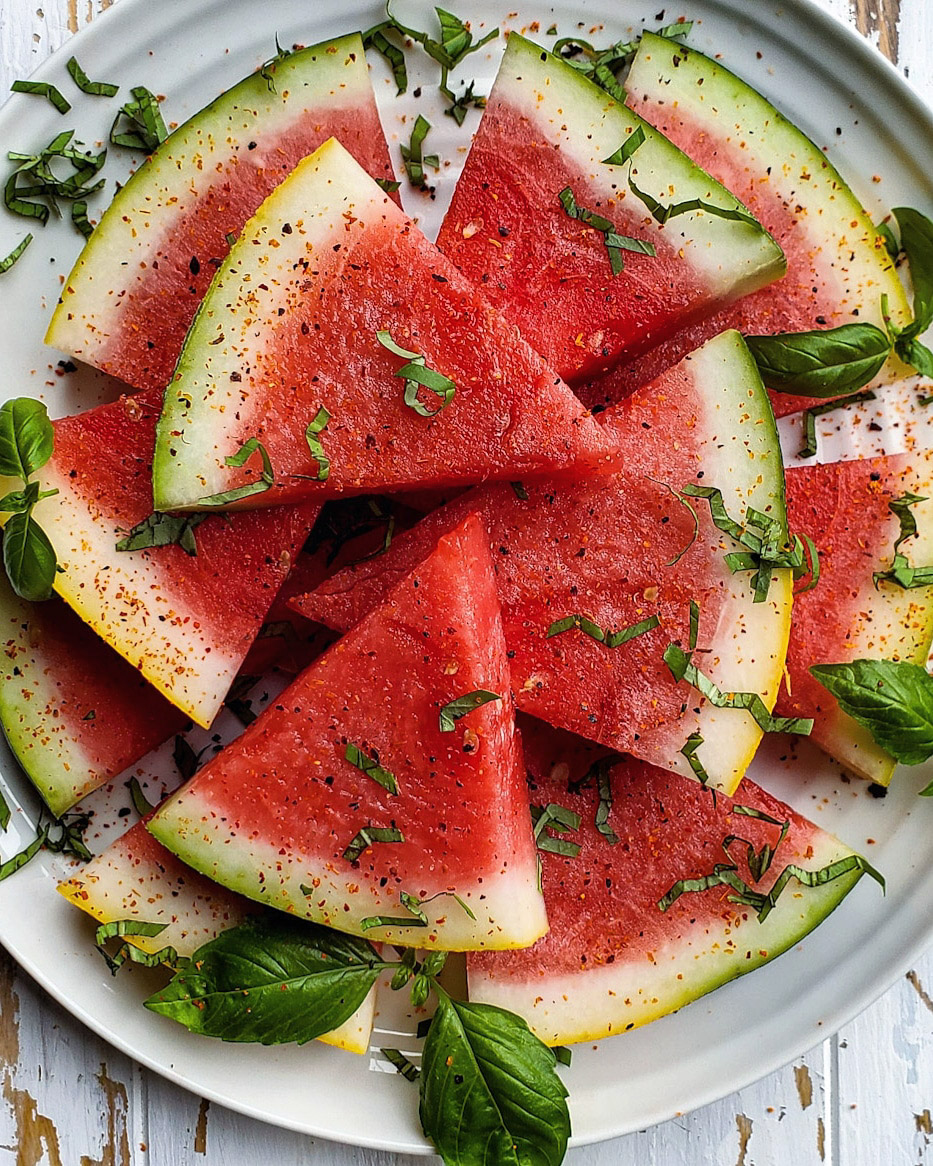

Watermelon All Dressed Up
Ingredients
- 1 medium watermelon
Topping Options
- Dukkah Blend see Notes for recipe link
- 1 to 2 tbsp Tajín spice blend see Notes for sourcing
- 1 to 2 tbsp Sumac
- extra virgin olive oil
- white balsamic vinegar
- 2 tbsp fresh chopped basil
- 2 tbsp fresh chopped mint
- freshly cracked black pepper
- flakey sea salt
Instructions
-
Cut the watermelon into wedges, cubes or spears
-
Pat dry if too much juice has been released.
-
Place onto a large platter
-
Choose which toppings you would like to use. If using Dukkah, you won't need anything else.
-
The Dukkah can be prepared and placed in a bowl set beside the platter for individual dipping, or sprinkled over the watermelon directly.
-
If using the olive oil and balsamic vinegar, the fresh herbs are a lovely textural contrast.
-
A drizzle of honey and lime with salt and pepper is fab.
-
The basil or mint will work great with the Tajín or Sumac as well.
-
See the Blog post for more suggestions.
-
Serve with toothpicks or bamboo skewers on the side if desired.
Recipe Notes
Here is my Dukkah recipe
Tajín spice blend can be found in the Mexican section of your grocery store these days. For sure specialty grocers will have it.

[…] Image source […]